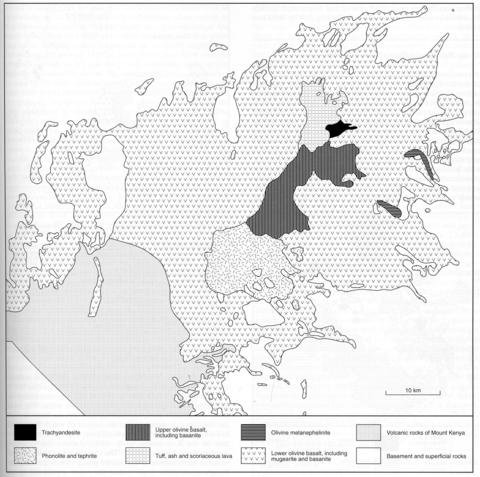stripes
The Nyambeni volcanic field lies immediately to the northeast of, and is continuous with, the Mount Kenya centre (No. 085-00-058) but is older. It extends over an area of about 150x100 km and is depicted on a geological map in Rix (1967, Fig. 3), who treats it as a discrete volcanic episode which he refers to as the ‘Nyambeni Volcanic Series’, although Hackman et al. (1989) argue for the more informal term ‘Nyambeni volcanics’. The map accompanying Hackman et al. (1989) is the more detailed for the central part of the field. The northeastern part of the area has been mapped and described by Williams (1966). The Nyambeni range comprises a multiple volcanic shield scattered with numerous clusters of volcanic cones that are generally aligned to the northeast and co-linear with Mount Kenya. The total thickness of the volcanic rocks is estimated at some 1500 m (Hackman et al., 1989). The general stratigraphy, according to Rix (1967), is lower olivine basalt, including melabasalt, mugearite and basanite; olivine melanephelinite; tuff, ash and scoriaceous lava; upper olivine basalt, including melabasalt and basanite; phonolite and tephrite; trachyandesite. However, the succession is undoubtedly more complex in detail, as is apparent from the account of Hackman et al. (1989) The lower olivine basalt group is by far the most voluminous and was extruded from fissures. Basanites within this series contain abundant zoned phenocrystal pyroxene, to which plagioclase is subordinate, olivine and interstitial groundmass nepheline. Nephelinite forms two discrete flows in the Kinna area (Rix, 1967) and has also been found just above Chanler’s Falls (Williams, 1966), while Jennings (1967) describes analcime-rich nephelinites from the Archer’s Post area on the northern side of the field. The pyroclastic rocks are generally confined to tuff and scoria cones concentrated in the northeast of the field and associated with the northeasterly-trending line of cones along the centre of the field. Hackman et al. (1989) describe a series of trachytes, rhyolites, tuffs and pumices that are difficult to correlate with the succession of Rix (1967). The trachytes, which are peralkaline, are present in isolated volcanic centres or cumulodomes and the rhyolites take the form of welded tuffs or ignimbrites. The upper group of olivine basalts is petrographically similar to the lower group, including the presence of model nepheline-bearing basanites, but confined to the central northeastern part of the area. These basalts have geomorphological features indicating their relatively recent age, including tuff cones, craters and flows (Hackman et al., 1989). Phonolite and subsidiary tephrite flows form the higher southern parts of the Nyambeni Range (Rix, 1967), the former in places building ‘cumulodomes’ from highly viscous flows (Hackman et al., 1989) . A typical phonolite is fine-grained and contains numerous micro-phenocrysts of nepheline in a trachytic groundmass of sanidine, aegirine-augite, interstitial nepheline, dendritic crystals of aenigmatite and katophorite. Details, including petrography, of phonolites from a number of localities are described by Hackman et al. (1989). A single flow of trachyandesite has been described from the northeast of the area by Williams (1966). Dal Negro et al. (1986) made a detailed crystal chemical study of pyroxenes in the nepheline-bearing lavas. Brotzu et al. (1983) give 94 whole rock analyses in their petrochemical study.
BROTZU, P., MORBIDELLI, L., PICCIRILLO, E.M. and TRAVERSA, G. 1983. The basanite to peralkaline phonolite suite of the Plioquaternary Nyambeni multicentre volcanic range (East Kenya Plateau). Neues Jahrbuch fur Mineralogie, Abhandlungen, 147: 253-80.BROTZU, P., MORBIDELLI, L., NICOLETTI, M., PICCIRILLO, E.M. and TRAVERSA, G. 1984. Miocene to Quaternary volcanism in eastern Kenya: sequence and geochronology. Tectonophysics, 101: 75-86.DAL NEGRO, A., CUNDARI, A., PICCIRILLO, E.M., MOLIN, G.M. and ULIANA, D. 1986. Distinctive crystal chemistry and site configuration of the clinopyroxene from alkali basaltic rocks. The Nyambeni clinopyroxene suite, Kenya. Contributions to Mineralogy and Petrology, 92: 35-43.HACKMAN, B.D., CHARSLEY, T.J., KAGASI, J., KEY, R.M., SIAMBI, W.S. and WILKINSON, A.F. 1989. Geology of the Isiolo area. Report, Mines and Geology Department, Nairobi, 103: 1-88.JENNINGS, D.J. 1967. Geology of the Archer’s Post area. Report, Geological Survey of Kenya, 77: 1-42.RIX, P. 1967. Geology of the Kinna area. Report, Geological Survey of Kenya, 81: 1-36.WILLIAMS, L.A.J. 1966. Geology of the Chanler’s Falls area. Report, Geological Survey of Kenya, 75: 1-54.

